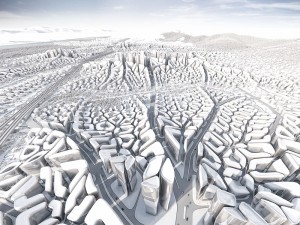F a b r I c a t I n g t h e F u t u r e
Neil Leach & Philip Yuan
Richard Aoun
Photo: Ursula Frick & Thomas Grabner
“Fabricating the Future” by Neil Leach and Philip Yuan concisely explains the era and concept of parametricism and digital fabrication. From exploring the factors that define the concept, the use of new techniques, the change of materiality, and eventually, the whole new approach of design. He focuses on digital tools, materials, digital fabrication, aesthetics, design approach and methodology. Neil Leach considers digital fabrication as a new style of architecture, a different approach rather than just visual values. He explains that digital tools, such as new software, are at ease between design and construction. “They provide an highway to explore architecture… as a series of inter-related and logically conceived parts assembled into a coherent whole.” This change in approach goes simultaneously with a change of process that digital fabrication brings forth. These new technologies change the previous modeling object design to a modeling process design.
An emphasis on hybrid materials and computational design is noticed on materials and machines. Mixed materials are a hybrid which brings forth the best of tectonic materials into a new material which performs better. New materials are considered more efficient. This efficiency in material is what should drive sustainability as it does in other design areas as industrial and machines. The idea is to achieve energy efficiency by lowering the ratio mass/performance which allows lower embedded energy and consumed energy in the life-cycle of the material. This is supported by machining sequence, in terms of design and fabrication. Leach supports the promotion of truly computational design where the machine adapts and develops designs rather than just helping the volume representation. “These changes provide novel possibilities for a material-oriented computational design approach in architecture.
Also, he considers that “placing digital fabrication as a tool or approach to architecture rather than a style or from decision maker. Negotiating and restraining the visual opulence of these compositions is an operation that entails elegance.” It is important to understand this, since algorithmic modeling and parametric design itself doesn’t bring aesthetic beauty by itself, but it requires the designers ability to bring forth the beauty out of the logic behind it. This process requires “a highly sophisticated formal language – including the driving force of aesthetic pleasure – propels elegance”.
Digital tools and fabrication is being used in the right way and following the right path as a leading power into our future. Parametricism is bought as a new style of architecture through new technologies, new fabrication processes and new approaches. To be ranked world widely, this new style has to be a leading force. It is therefore very important to research the low-cost applications of architecture. This can lead to design activism chances in needed areas around the world.

